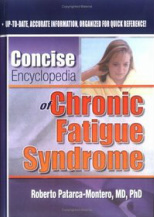
With admirable thoroughness, Roberto Patarca Montero has assembled, categorized and organized a decade of CFS research (up to the year 2000). Patarca has left no topic out, from AIDS (which has no bearing on CFS) to Yersinia (which also has no bearing on CFS). Fortunately, he covers everything in between--most of which, thankfully, does have bearing on CFS. However, it is Patarca's failing that in his zeal to leave nothing out, he makes no distinction between research that is relevant and research which isn't.
If you are looking for everything that has been published--the good, the bad, and the ugly--you will find it all among these pages. (Although, if you want to save time and energy, I'd recommend bypassing the contents and going straight to the Notes section.) To be fair, Patarca devotes most of this book to legitimate research on immune system dysfunction, neuroendocrine system abnormalities, the role of viruses in CFS etiology, and symptoms. However, Patarca also includes some deeply flawed studies with a credulity that makes you wonder if he understands what he is reading. Under "Quality of Life," for example, Patarca states that "quality of life correlates with the hypochondriacal disposition of CFS patients toward illness." To back up this outrageous assertion, he cites a 1996 NIH-funded study published by Manu, Affleck et al in the journal, Psychotherapy and Psychosomatics. (It is worth mentioning here that the first author of the study was a consultant for Metlife Insurance Company. Due to his blatant conflict of interests, anything Manu has published concerning CFS must automatically be treated as irreparably biased.) The uncritical inclusion of such shoddy, ill-conceived "research" is shameful.
It is equally as reprehensible for Patarca Montero to include "fatigue state" studies in a book about CFS. Research which is based on self-reported "fatigue" has absolutely no relevance to CFS. Aside from the fact that self-reporting is not a valid criterion in a medical study, fatigue is not the defining characteristic of CFS. Post-exertional malaise, that is, a worsening of all symptoms after physical or mental exertion, is what distinguishes CFS from "fatigue states." The fact that Patarca does not distinguish between the two simply adds confusion, and obfuscates the solid research that has been conducted using established CFS case definitions.
As useful as this book might be for researchers, I would not recommend it to either doctors or patients. The lack of "quality control" will leave doctors with a confusing, meaningless and often contradictory jumble of statistics. Patients will also be frustrated by the plethora of uninterpreted information. If you are looking for a fairly short introduction to the disease process itself, I would recommend Dr. Bell's book, Cellular Hypoxia and Neuro-Immune Fatigue. If you are a patient looking for practical advice, read Hope and Help for CFS. And if you would like to delve more deeply into the physiological aspects of CFS, The Clinical and Scientific Basis of Myalgic Encephalomyelitis/Chronic Fatigue Syndrome edited by Byron Hyde and Jay Goldstein is still the most cogent and useful publication available.
Available on Amazon here and on Barnes & Noble here.

 RSS Feed
RSS Feed
